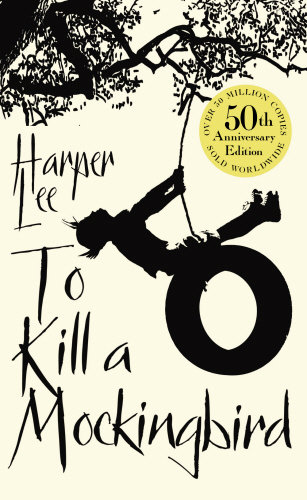- To Kill a Mocingbird(South Gothic/Bildungsroman)

To Kill a Mockingbird is a novel by Harper Lee published in 1960. It was immediately successful, winning the Pulitzer Prize, and has become a classic of modern American literature. The plot and characters are loosely based on the author's observations of her family and neighbors, as well as on an event that occurred near her hometown in 1936, when she was 10 years old.
The novel is renowned for its warmth and humor, despite dealing with the serious issues of rape and racial inequality. The narrator's father, Atticus Finch, has served as a moral hero for many readers and as a model of integrity for lawyers. One critic explains the novel's impact by writing, "In the twentieth century, To Kill a Mockingbird is probably the most widely read book dealing with race in America, and its protagonist, Atticus Finch, the most enduring fictional image of racial heroism."
As a Southern Gothic novel and a Bildungsroman, the primary themes of To Kill a Mockingbird involve racial injustice and the destruction of innocence. Scholars have noted that Lee also addresses issues of class, courage, compassion, and gender roles in the American Deep South. The book is widely taught in schools in the United States with lessons that emphasize tolerance and decry prejudice. Despite its themes, To Kill a Mockingbird has been subject to campaigns for removal from public classrooms, often challenged for its use of racial epithets.
- Harper Lee
◎ Harper Lee's To Kill a Mockingbird Summery
▴"Stand up your father is passing."-video
▴ For White only
By the late 1870s Reconstruction was coming to an end. In the name of healing the wounds between North and South, most white politicians abandoned the cause of protecting African Americans.
In the former Confederacy and neighboring states, local governments constructed a legal system aimed at re-establishing a society based on white supremacy. African American men were largely barred from voting. Legislation known as Jim Crow laws separated people of color from whites in schools, housing, jobs, and public gathering places.
◎Montgomery bus boycott
The Montgomery bus boycott, a seminal event in the Civil Rights Movement, was a political and social protest campaign against the policy of racial segregation on the public transit system of Montgomery, Alabama. The campaign lasted from December 5, 1955—when Rosa Parks, an African American woman, was arrested for refusing to surrender her seat to a white person—to December 20, 1956, when a federal ruling, Browder v. Gayle, took effect, and led to a United States Supreme Court decision that declared the Alabama and Montgomery laws requiring segregated buses to be unconstitutional. Many important figures in the Civil Rights Movement took part in the boycott, including Reverend Martin Luther King Jr. and Ralph Abernathy.
- Peeping Tom偷窺狂
The story of "Peeping Tom", who alone among the townsfolk spied on the Lady Godiva's naked ride, probably did not originate in literature, but came about through popular lore in the locality of Coventry. Reference by 17th-century chroniclers has been claimed, but all the published accounts are 18th-century or later.
◎ Lady Godiva
Godiva, Countess of Mercia (/ɡəˈdaɪvə/; d.–1067), in Old English Godgifu, was an English noblewoman who, according to a legend dating at least to the 13th century, rode naked – covered only in her long hair – through the streets of Coventry to gain a remission of the oppressive taxation that her husband imposed on his tenants. The name "Peeping Tom" for a voyeur originates from later versions of this legend in which a man named Tom watched her ride and was struck blind or dead.

- Doubting Thomas
A doubting Thomas is a skeptic who refuses to believe without direct personal experience—a reference to the Apostle Thomas, who refused to believe that the resurrected Jesus had appeared to the ten other apostles, until he could see and feel the wounds received by Jesus on the cross.
In art, the episode (formally called the Incredulity of Thomas) has been frequently depicted since at least the 5th century, with its depiction reflecting a range of theological interpretations.

◎ 1933Inaugural speech
'' We have nothing to fear but fear itself.'' - Franklin Delano Roosevelt
- Death of Yoshihiro Hattori
Yoshihiro Hattori (服部 剛丈 Hattori Yoshihiro?, November 22, 1975 – October 17, 1992) was a Japanese exchange student residing in Baton Rouge, Louisiana, United States, at the time of his death. Hattori was on his way to a Halloween party and went to the wrong house by accident. The property owner, Rodney Peairs, shot and killed Hattori, thinking he was trespassing with criminal intent. The homicide and Peairs' acquittal in the state court of Louisiana received worldwide attention.
He pointed the gun at Hattori and yelled,
"Freeze!"
Hattori stepped back toward the house, saying.
"We're here for the party."
Haymaker spotted the weapon and shouted a warning after Hattori
- Prefixs/ Root/ Suffixes
◎ se- apart from eg. select/ seperate
◎ mal- something bad↔bene- something good
◎ mal- something bad eg. malevolent/ malicious/ maligne
◎ bene- something good eg. benevolent/ benefit/ beneficiary
- Vocabularies
◎ defendant 被告人
◎ attorney 律師
◎ victim 被害人
◎ jury 陪審團
* Q: Do the jury have/reach the verdict? 陪審團有達成共識嗎?
A: Yes, we do, your honor. We found the defendant guilty/ not guilty.

沒有留言:
張貼留言